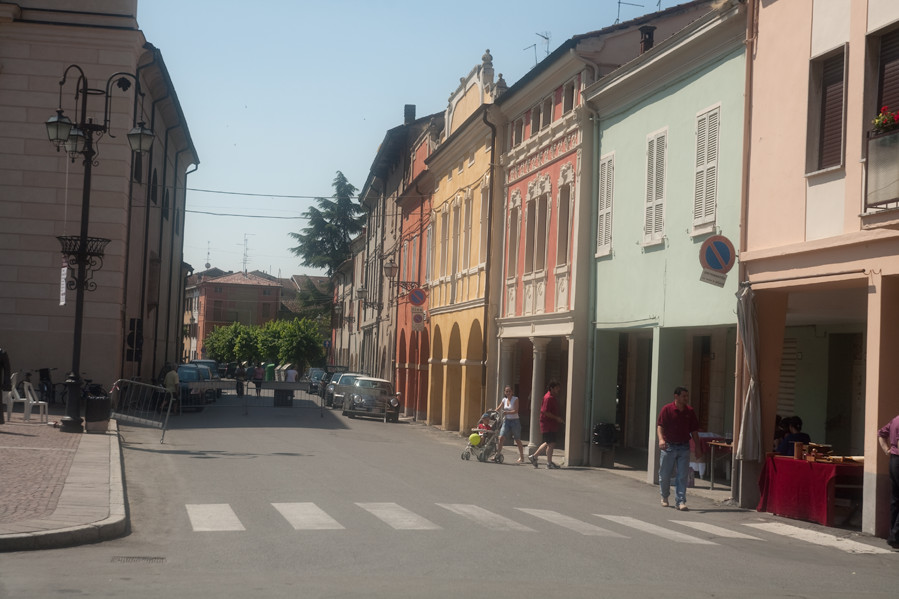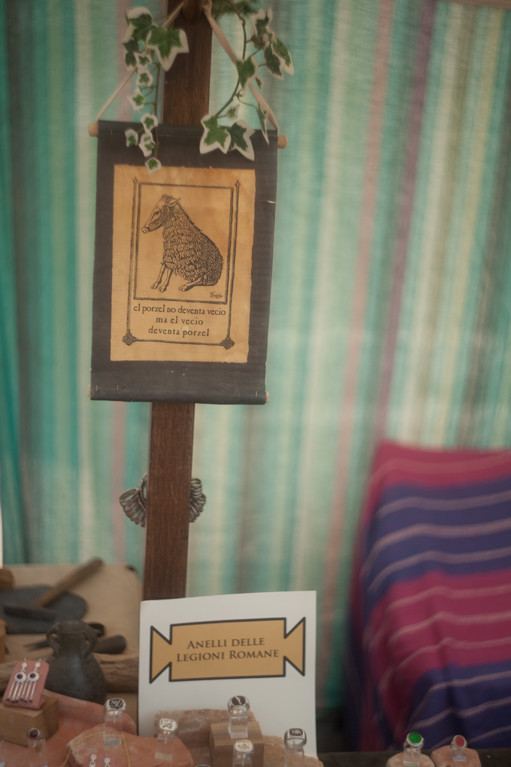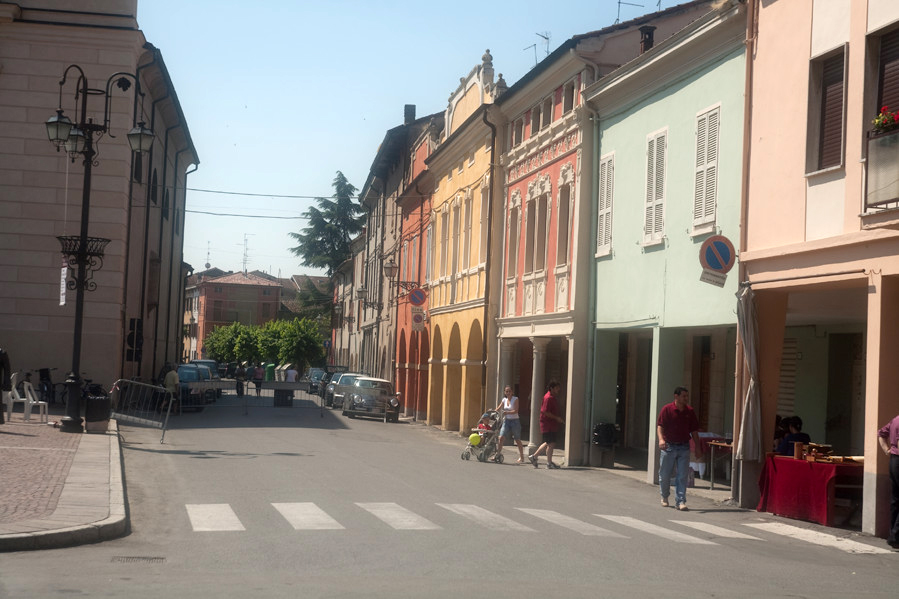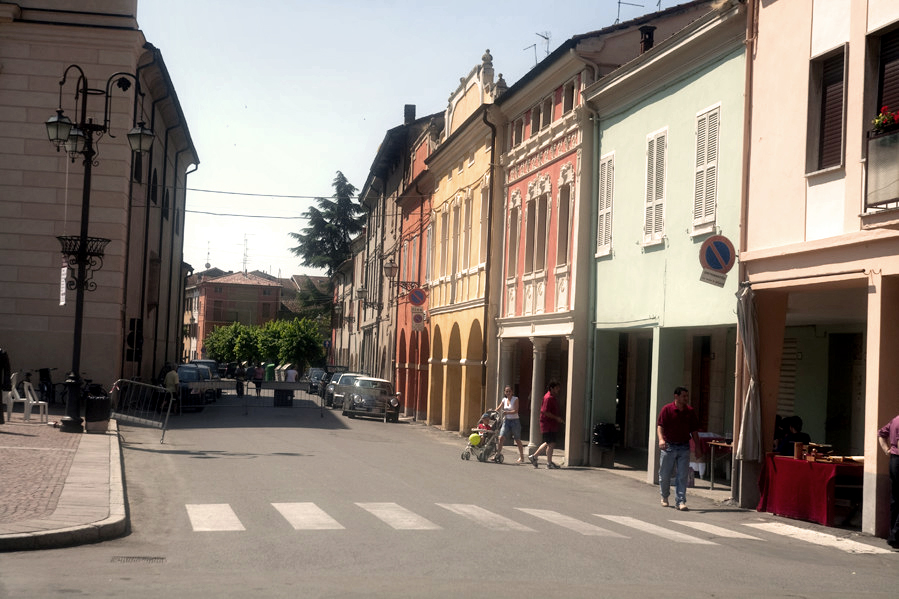| View previous topic :: View next topic |
| Author |
Message |
Orio

Joined: 24 Feb 2007
Posts: 29545
Location: West Emilia
Expire: 2012-12-04
|
 Posted: Tue Sep 29, 2009 2:12 pm Post subject: "Zeissifier" in action Posted: Tue Sep 29, 2009 2:12 pm Post subject: "Zeissifier" in action |
 |
|
Orio wrote:
These two pictures were taken last year with a flaring Helios-44-M-4.
Shown here the "before" and "after" zeissifier versions 




_________________
Orio, Administrator
T*
NE CEDE MALIS AUDENTIOR ITO
Ferrania film is reborn! http://www.filmferrania.it/
Support the Ornano film chemicals company and help them survive!
http://forum.mflenses.com/ornano-chemical-products-t55525.html |
|
| Back to top |
|
 |
PaulC


Joined: 23 Dec 2008
Posts: 2318
|
 Posted: Tue Sep 29, 2009 2:25 pm Post subject: Posted: Tue Sep 29, 2009 2:25 pm Post subject: |
 |
|
PaulC wrote:
Hmmm... well, you can boost the contrast and maybe add a little sharpening but you can never add any information to the picture that wasn't there before.
In small sizes you may be able to Zeissify enough to persuade people it is as good as a real, well-shot Zeiss image but the defects will start to show again (probably even worse than in the original) if you have to blow the thing up to a large size. IMHO
_________________
View or buy my photos at:
http://shutterstock.com/g/paulcowan |
|
| Back to top |
|
 |
Orio

Joined: 24 Feb 2007
Posts: 29545
Location: West Emilia
Expire: 2012-12-04
|
 Posted: Tue Sep 29, 2009 2:44 pm Post subject: Posted: Tue Sep 29, 2009 2:44 pm Post subject: |
 |
|
Orio wrote:
| PaulC wrote: |
Hmmm... well, you can boost the contrast and maybe add a little sharpening but you can never add any information to the picture that wasn't there before.
In small sizes you may be able to Zeissify enough to persuade people it is as good as a real, well-shot Zeiss image but the defects will start to show again (probably even worse than in the original) if you have to blow the thing up to a large size. IMHO |
Yes of course.
It's just a little play 
_________________
Orio, Administrator
T*
NE CEDE MALIS AUDENTIOR ITO
Ferrania film is reborn! http://www.filmferrania.it/
Support the Ornano film chemicals company and help them survive!
http://forum.mflenses.com/ornano-chemical-products-t55525.html |
|
| Back to top |
|
 |
LucisPictor


Joined: 26 Feb 2007
Posts: 17633
Location: Oberhessen, Germany / Maidstone ('95-'96)
Expire: 2013-12-03
|
 Posted: Tue Sep 29, 2009 3:01 pm Post subject: Posted: Tue Sep 29, 2009 3:01 pm Post subject: |
 |
|
LucisPictor wrote:
| Orio wrote: |
It's just a little play  |
But a very nice one!
And it helps to improve the pictures.
It would a bad thing to have a prog that produces Zeiss image quality based on any cheap lens you can buy. The value of really good lenses would drop intensely and thus the value of our collections.
But then, we could buy many great lenses for little money... Hmmm....
_________________
Personal forum activity on pause every now and again (due to job obligations)!
Carsten, former Moderator 
Things ON SALE
Carsten = "KAPCTEH" = "Karusutenu" | T-shirt?.........................My photos from Emilia: http://www.schouler.net/emilia/emilia2011.html
My gear: http://retrocameracs.wordpress.com/ausrustung/
Old list: http://forum.mflenses.com/viewtopic.php?t=65 (Not up-to-date, sorry!) | http://www.lucispictor.de | http://www.alensaweek.wordpress.com |
http://www.retrocamera.de |
|
| Back to top |
|
 |
Laurence


Joined: 26 Mar 2007
Posts: 4809
Location: Western Washington State
Expire: 2016-06-19
|
 Posted: Tue Sep 29, 2009 4:40 pm Post subject: Posted: Tue Sep 29, 2009 4:40 pm Post subject: |
 |
|
Laurence wrote:
Orio, I'm looking for a program with similar results. Do you know of a software program that will CREATE a Zeiss lens for me?
_________________
Assent, and you are sane;
Demur,—you ’re straightway dangerous,
And handled with a chain.
Emily Dickinson
Cameras and Lenses in Use:
Yashica Mat 124 w/ Yashinon 80/3.5,
CV Apo-Lanthar 90/3.5SL, (Thank you Klaus),
Pentax 645,
Flek 50,
Pentax-A 150
Pentax-A 120 Macro
Voigtlander Vitomatic I w/Color Skopar 50/2.8
Konica TC and zoom lenses (thanks Carsten)
Contax AX
Yashica ML 50/2
Yashica ML 35/2.8
Carl Zeiss Contax 50/1.4
Tamron Adaptall SP 17/3.5
Tamron Adaptall 28/2.5
Tamron Adaptall SP 300/2.8 LD (IF)
|
|
| Back to top |
|
 |
Nesster


Joined: 24 Apr 2008
Posts: 5883
Location: NJ, USA
Expire: 2014-02-20
|
 Posted: Tue Sep 29, 2009 5:03 pm Post subject: Posted: Tue Sep 29, 2009 5:03 pm Post subject: |
 |
|
Nesster wrote:
With a bit of digital processing, one ought to be able to create a Zeiss filter given two optical transfer functions.
Sort of like in audio: take two transfer functions, and apply digital correction to one to match the other. In theory of course, provided there is enough signal headroom etc in the inferior system to match the better one.
Of course, with the coming nano technology, we ought to be able to instruct the wee critters to attack our Domiplan in a way to resculpt the elements into Zeiss like glass... 
_________________
-Jussi
Camera photos
Print Photographica
|
|
| Back to top |
|
 |
patrickh


Joined: 23 Aug 2007
Posts: 8551
Location: Oregon
Expire: 2011-11-18
|
 Posted: Tue Sep 29, 2009 7:04 pm Post subject: Posted: Tue Sep 29, 2009 7:04 pm Post subject: |
 |
|
patrickh wrote:
Neat Orio and very generous to offer the fruits of your labour.
Laurence, welcome back and I am sure someone will find a way to grant your wish (perhaps the tooth fairy?)  
patrickh
_________________
DSLR: Nikon D300 Nikon D200 Nex 5N
MF Zooms: Kiron 28-85/3.5, 28-105/3.2, 75-150/3.5, Nikkor 50-135/3.5 AIS // MF Primes: Nikkor 20/4 AI, 24/2 AI, 28/2 AI, 28/2.8 AIS, 28/3.5 AI, 35/1.4 AIS, 35/2 AIS, 35/2.8 PC, 45/2.8 P, 50/1.4 AIS, 50/1.8 AIS, 50/2 AI, 55/2.8 AIS micro, 55/3.5 AI micro, 85/2 AI, 100/2,8 E, 105/1,8 AIS, 105/2,5 AIS, 135/2 AIS, 135/2.8 AIS, 200/4 AI, 200/4 AIS micro, 300/4.5 AI, 300/4.5 AI ED, Arsat 50/1.4, Kiron 28/2, Vivitar 28/2.5, Panagor 135/2.8, Tamron 28/2.5, Tamron 90/2.5 macro, Vivitar 90/2.5 macro (Tokina) Voigtlander 90/3.5 Vivitar 105/2.5 macro (Kiron) Kaleinar 100/2.8 AI Tamron 135/2.5, Vivitar 135/2.8CF, 200/3.5, Tokina 400/5,6
M42: Vivitar 28/2.5, Tamron 28/2.5, Formula5 28/2.8, Mamiya 28/2.8, Pentacon 29/2.8, Flektogon 35/2.4, Flektogon 35/2.8, Takumar 35/3.5, Curtagon 35/4, Takumar 50/1.4, Volna-6 50/2.8 macro, Mamiya 50/1.4, CZJ Pancolar 50/1,8, Oreston 50/1.8, Takumar 50/2, Industar 50/3.5, Sears 55/1.4, Helios 58/2, Jupiter 85/2, Helios 85/1.5, Takumar 105/2.8, Steinheil macro 105/4.5, Tamron 135/2.5, Jupiter 135/4, CZ 135/4, Steinheil Culminar 135/4,5, Jupiter 135/3.5, Takumar 135/3.5, Tair 135/2.8, Pentacon 135/2.8, CZ 135/2.8, Taika 135/3.5, Takumar 150/4, Jupiter 200/4, Takumar 200/4
Exakta: Topcon 100/2.8(M42), 35/2.8, 58/1.8, 135/2.8, 135/2.8 (M42), Kyoei Acall 135/3.5
C/Y: Yashica 28/2.8, 50/1.7, 135/2.8, Zeiss Planar 50/1.4, Distagon 25/2.8
Hexanon: 28/3.5, 35/2.8, 40/1.8, 50/1.7, 52/1.8, 135/3.2, 135/3.5, 35-70/3.5, 200/3.5
P6 : Mir 38 65/3.5, Biometar 80/2.8, Kaleinar 150/2.8, Sonnar 180/2.8
Minolta SR: 28/2.8, 28/3.5, 35/2.8, 45/2, 50/2, 58/1.4, 50/1.7, 135/2.8, 200/3.5
RF: Industar 53/2.8, Jupiter 8 50/2
Enlarg: Rodagon 50/5,6, 80/5,6, 105/5.6, Vario 44-52/4, 150/5.6 180/5.6 El Nikkor 50/2,8,63/2.8,75/4, 80/5,6, 105/5.6, 135/5.6 Schneider 60/5.6, 80/5.6, 80/4S,100/5.6S,105/5.6,135/5.6, 135/5.6S, 150/5.6S, Leica 95/4 |
|
| Back to top |
|
 |
Attila


Joined: 24 Feb 2007
Posts: 57865
Location: Hungary
Expire: 2025-11-18
|
 Posted: Tue Sep 29, 2009 7:29 pm Post subject: Posted: Tue Sep 29, 2009 7:29 pm Post subject: |
 |
|
Attila wrote:
| Laurence wrote: |
| Orio, I'm looking for a program with similar results. Do you know of a software program that will CREATE a Zeiss lens for me? |
Acdsee makes damn good job with easy to use interface if need to make more contrasty pictures.
_________________
-------------------------------
Items on sale on Ebay
Sony NEX-7 Carl Zeiss Planar 85mm f1.4, Minolta MD 35mm f1.8, Konica 135mm f2.5, Minolta MD 50mm f1.2, Minolta MD 250mm f5.6, Carl Zeiss Sonnar 180mm f2.8
|
|
| Back to top |
|
 |
PaulC


Joined: 23 Dec 2008
Posts: 2318
|
 Posted: Tue Sep 29, 2009 9:14 pm Post subject: Posted: Tue Sep 29, 2009 9:14 pm Post subject: |
 |
|
PaulC wrote:
Photoshop's "auto contrast" button is quite handy, too, for a one-click solution:

_________________
View or buy my photos at:
http://shutterstock.com/g/paulcowan |
|
| Back to top |
|
 |
Orio

Joined: 24 Feb 2007
Posts: 29545
Location: West Emilia
Expire: 2012-12-04
|
 Posted: Tue Sep 29, 2009 10:11 pm Post subject: Posted: Tue Sep 29, 2009 10:11 pm Post subject: |
 |
|
Orio wrote:
Guys what I did was not simply increase contrast in the way as ACDSee or the auto contrast function (a real picture killer) of Photoshop do, that is, optimizing the black and white point.
Paul if you look at your modification, Photoshop has modified the white and black points, which improved overall contrast, but has not modified the character of the picture, which remains flarish.
My action (which is simply an unsharp mask operation) has actually changed the character of the picture, which is not flarish anymore.
In the second picture the action transformed what was a flat looking image, into an image with decent "3D". Nowhere like a real zeiss lens, but considering the starting point, I say, not bad...
_________________
Orio, Administrator
T*
NE CEDE MALIS AUDENTIOR ITO
Ferrania film is reborn! http://www.filmferrania.it/
Support the Ornano film chemicals company and help them survive!
http://forum.mflenses.com/ornano-chemical-products-t55525.html |
|
| Back to top |
|
 |
Orio

Joined: 24 Feb 2007
Posts: 29545
Location: West Emilia
Expire: 2012-12-04
|
 Posted: Tue Sep 29, 2009 10:19 pm Post subject: Posted: Tue Sep 29, 2009 10:19 pm Post subject: |
 |
|
Orio wrote:
| Attila wrote: |
| Laurence wrote: |
| Orio, I'm looking for a program with similar results. Do you know of a software program that will CREATE a Zeiss lens for me? |
Acdsee makes damn good job with easy to use interface if need to make more contrasty pictures. |
Contrast adjustment will not modify the picture the way I did it.
Contrast control sets the extreme values of an image to the limits (or less). This is done on a whole image basis and does not take into account the neighboring pixel values.
My action did improve the contrast by way of increasing the micro-contrast, that is, the neighbouring pixels with a luminance value difference within a certain range, were modified, the other pixels were not.
This operation modified the image where it was necessary, whereas a general contrast control acts like a 5 kilos hammer to open a nutshell... that is, it impacts both the shell and the fruit...
_________________
Orio, Administrator
T*
NE CEDE MALIS AUDENTIOR ITO
Ferrania film is reborn! http://www.filmferrania.it/
Support the Ornano film chemicals company and help them survive!
http://forum.mflenses.com/ornano-chemical-products-t55525.html |
|
| Back to top |
|
 |
Orio

Joined: 24 Feb 2007
Posts: 29545
Location: West Emilia
Expire: 2012-12-04
|
 Posted: Tue Sep 29, 2009 10:28 pm Post subject: Posted: Tue Sep 29, 2009 10:28 pm Post subject: |
 |
|
Orio wrote:
| patrickh wrote: |
Neat Orio and very generous to offer the fruits of your labour.
patrickh |
Patrick, I just recorded into some actions a knowledge that is widely available over the internet about how to modify microcontrast in an image.
It was really a 5 minutes thingy 
_________________
Orio, Administrator
T*
NE CEDE MALIS AUDENTIOR ITO
Ferrania film is reborn! http://www.filmferrania.it/
Support the Ornano film chemicals company and help them survive!
http://forum.mflenses.com/ornano-chemical-products-t55525.html |
|
| Back to top |
|
 |
PaulC


Joined: 23 Dec 2008
Posts: 2318
|
 Posted: Tue Sep 29, 2009 10:31 pm Post subject: Posted: Tue Sep 29, 2009 10:31 pm Post subject: |
 |
|
PaulC wrote:
Yes, indeed. I was messing about and did get a much better version after running USM on it at about 20% with a radius of 100 and then playing about with saturation and one or two ther things but I couldn't quite duplicate your effect.
What you say about auto contrast is interesting, particularly in relation to using uncoated lenses.
Unfortunately, understanding photoshop is almost more important than understanding photography these days, if you want to get decent results. And PS is very difficult to learn so each bit of information is valuable.
Actually, a straightforward USM amount 20, radius 100 gets pretty close, I think.

_________________
View or buy my photos at:
http://shutterstock.com/g/paulcowan |
|
| Back to top |
|
 |
Orio

Joined: 24 Feb 2007
Posts: 29545
Location: West Emilia
Expire: 2012-12-04
|
 Posted: Tue Sep 29, 2009 10:48 pm Post subject: Posted: Tue Sep 29, 2009 10:48 pm Post subject: |
 |
|
Orio wrote:
| PaulC wrote: |
Unfortunately, understanding photoshop is almost more important than understanding photography these days |
I agree, but I would modify a bit, because it's not only true for these days, in the past photographers also had to understand chemicals, development and printing procedures...
Photography is an art whose technological side is fairly advanced and mastering it (or at least handling it) is part of the skills.
I see it this way: if someone make digital photographs with more than a tourist or family user attitude, he has to learn at least the basics of digital editing, not leave it all to the machines. It's part of the process, exactly like the film photographer needs to know the basics of developing and printing.
For those on a budget, it's not necessary to buy Photoshop. Affordable programs like Paint Shop Pro let you do what I did in the actions and more, they allow you to do everything that a digital photographer needs to do, with an expense that is very small.
_________________
Orio, Administrator
T*
NE CEDE MALIS AUDENTIOR ITO
Ferrania film is reborn! http://www.filmferrania.it/
Support the Ornano film chemicals company and help them survive!
http://forum.mflenses.com/ornano-chemical-products-t55525.html |
|
| Back to top |
|
 |
Orio

Joined: 24 Feb 2007
Posts: 29545
Location: West Emilia
Expire: 2012-12-04
|
 Posted: Tue Sep 29, 2009 10:51 pm Post subject: Posted: Tue Sep 29, 2009 10:51 pm Post subject: |
 |
|
Orio wrote:
| PaulC wrote: |
Actually, a straightforward USM amount 20, radius 100 gets pretty close, I think. |
yes, that is what I did, straightforward USM, although my used values were slightly different.
One should never use the Contrast control to adjust contrast, except for those desperate cases where the original picture is so bad that you need to actually hammer it in order to bring something out.
_________________
Orio, Administrator
T*
NE CEDE MALIS AUDENTIOR ITO
Ferrania film is reborn! http://www.filmferrania.it/
Support the Ornano film chemicals company and help them survive!
http://forum.mflenses.com/ornano-chemical-products-t55525.html |
|
| Back to top |
|
 |
PaulC


Joined: 23 Dec 2008
Posts: 2318
|
 Posted: Tue Sep 29, 2009 11:01 pm Post subject: Posted: Tue Sep 29, 2009 11:01 pm Post subject: |
 |
|
PaulC wrote:
This is true, but I have the feeling that we have a massively greater range of variables available to us now than in the days of film - and I did develop and printed B&W in the 80s, not to top pro standards but with pretty good results.
I've spent several years working with PS and trying to get to grips with what I need, but I still know only a tiny fraction of what it can do.
_________________
View or buy my photos at:
http://shutterstock.com/g/paulcowan |
|
| Back to top |
|
 |
PaulC


Joined: 23 Dec 2008
Posts: 2318
|
 Posted: Tue Sep 29, 2009 11:10 pm Post subject: Posted: Tue Sep 29, 2009 11:10 pm Post subject: |
 |
|
PaulC wrote:
| Orio wrote: |
| PaulC wrote: |
Actually, a straightforward USM amount 20, radius 100 gets pretty close, I think. |
yes, that is what I did, straightforward USM, although my used values were slightly different.
One should never use the Contrast control to adjust contrast, except for those desperate cases where the original picture is so bad that you need to actually hammer it in order to bring something out. |
Every day I learn something new. I read about USM "polishing" actions five years ago when I got my 300D (my first digital camera) but the stock agencies I got involved with demand photos whigh are not sharpened, so all this time I have been using contrast and autocontrast controls instead of USM.
The competition is so stiff now that a tiny improvement in techniques can make all the difference between getting sales or not, so this sort of information is really valuable to me.
_________________
View or buy my photos at:
http://shutterstock.com/g/paulcowan |
|
| Back to top |
|
 |
|
|
